Everybody needs good neighbours in Neukölln, Berlin
Published on
The district is famed for its media coverage of violence and failed integration. Yet it is also a recent example of Berlin’s gentrification. Of its 315, 000 residents, 41% are migrants; more than one in five are unemployed. A city magazine recently declared my street to be one of the trendiest places in Berlin.
But what do the inhabitants see in this place, asks German journalist Franziska Hessberger (Translation by Hannah Keet)
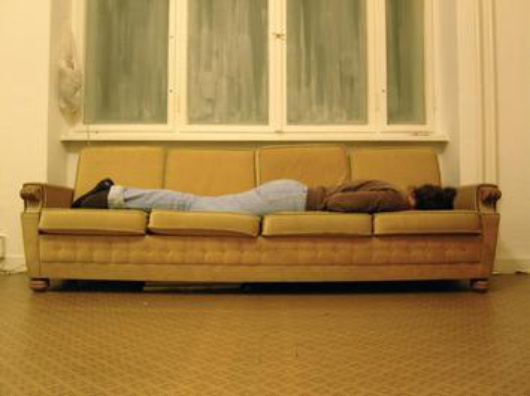 (Image: (cc) kbirkenbach/
Flickr)
(Image: (cc) kbirkenbach/
Flickr)
EugenWeichselstraße11amno. 62 Weichselstraße80 centsBerliner
I live here, too
Eugen is Austrian and has been living in Neukölln for thirty years. He sneers when I tell him I live here, too. Yet after ten minutes he offers me a seat next to him on the wooden bench and a swig of his bottle of booze, since I’m now a Berliner as well. He did all sorts after studying art; he still draws. If material is in short supply, he also uses cigarette ash and spit. Eugen spent some time in a monastery in Kathmandu and in a cave in northern Spain, but he comes back to Neukölln time after time. People leave him alone here. ‘The most important thing in life is freedom. I have that here,’ he philosophises.
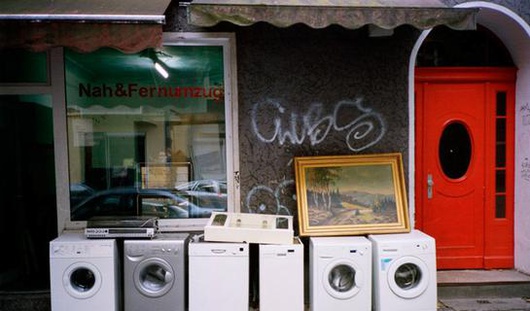 The estate sales business has been running for the past
fifteen years | © Luka Knezevic-Strika
The estate sales business has been running for the past
fifteen years | © Luka Knezevic-Strika
Helge‘s kitchen is exactly above mine. He moved into the apartment 26 years ago on a Sunday morning; the architect has been living at no. 66 Weichselstraße ever since. The 70-year-old seems amazingly youthful, as does his apartment. In 1986, when he moved in, the Berlin wall stood at the end of Weichselstraße. The control area began at the upper end. The street was avoided a lot of the time. It was quiet. But the unusual atmosphere has not changed since then: ‘Being able to make something from nothing was and is appealing,’ he says. ‘Everything was simple and stayed simple, too.’ There are still many small studios and galleries, but they don’t stay open for long.
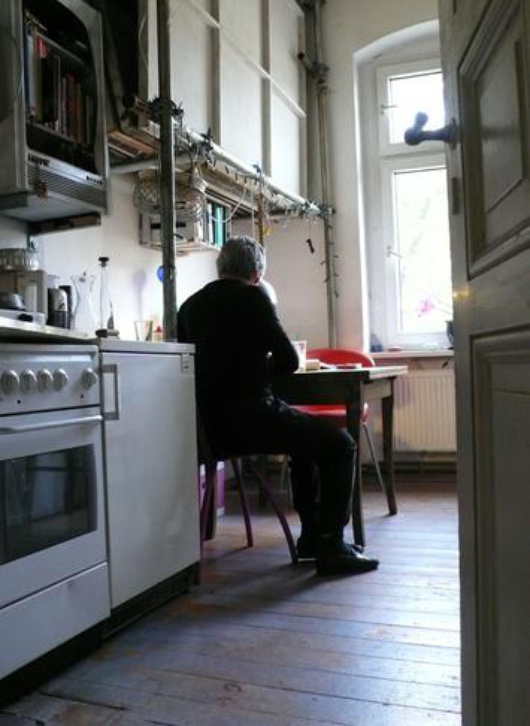 Helge in his kitchen | ©
Franziska Hessberger
Helge in his kitchen | ©
Franziska Hessberger
Rent hike
It takes me ten minutes to walk along the 850-metre Weichselstraße. Decorated pre-war buildings are scattered among buildings constructed in the 1950s. Graffiti sprayers dabble on the building walls. I count no more than twenty bars, cafés and restaurants. There’s an organic supermarket opposite the discount store. The organic ice cream parlour and the kiosk are just one hundred metres apart. The last building at the upper end of the street is number 34. Annette, a journalist, lived there until 2005. ‘Seven years ago there wasn’t even one bar, just Turkish bakeries and electrical goods shops. There were syringes lying around in the playground over there,’ she says. The ground floor of her building, like so many others, was boarded up until 2006 when Cafe Rudimarie opened. Nowadays, stylish parents get themselves a coffee to go before they head to the playground next door.
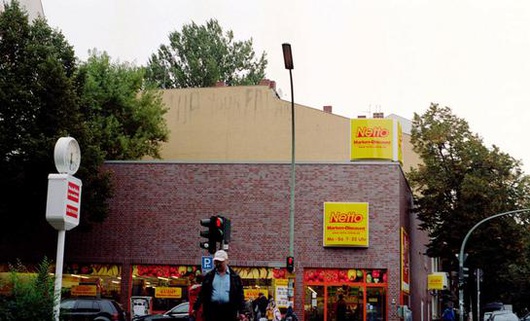 The prices at Cafe Rudimarie remind Thomas
of the lifestyle in Friedrichshain,
another district of Berlin - so do the expensive rent prices and the
hipsters who he came to Neukölln to escape. ‘It used to be more mixed
here,’ he explains. ‘Now only a certain few can afford an apartment
here.’ There are forty
tenants in nos. 37 and 38. Over the past two
years, the tenants have changed in thirty
of these apartments due to the increasing rents after refurbishment.
Hardly anyone moved out voluntarily. Thomas’ 80
metres squared apartment with stove heating costs 380 euros per month. After redevelopment, the
rent will rise to 750 euros.
‘Property managers are transferring the costs to the residents and rent
prices are increasing,’ says Thomas. ‘When everything is paid off in ten years’ time, the rent prices will stay
high. Nobody acts in a socially responsible manner around here!’ He was
one of the only people in the building to take legal action against the
increase in rent. He lost the first lawsuit, but he is still suing. If
nothing changes, he’ll move away.
The prices at Cafe Rudimarie remind Thomas
of the lifestyle in Friedrichshain,
another district of Berlin - so do the expensive rent prices and the
hipsters who he came to Neukölln to escape. ‘It used to be more mixed
here,’ he explains. ‘Now only a certain few can afford an apartment
here.’ There are forty
tenants in nos. 37 and 38. Over the past two
years, the tenants have changed in thirty
of these apartments due to the increasing rents after refurbishment.
Hardly anyone moved out voluntarily. Thomas’ 80
metres squared apartment with stove heating costs 380 euros per month. After redevelopment, the
rent will rise to 750 euros.
‘Property managers are transferring the costs to the residents and rent
prices are increasing,’ says Thomas. ‘When everything is paid off in ten years’ time, the rent prices will stay
high. Nobody acts in a socially responsible manner around here!’ He was
one of the only people in the building to take legal action against the
increase in rent. He lost the first lawsuit, but he is still suing. If
nothing changes, he’ll move away.
A cinema-cum-cheap supermarket | © Luka Knezevic-Strika
There is a café nearby that Thomas has never been to which opened two and a half years ago. It has large windows and old furniture inside. During its renovation, curious residents would often take a peek inside. The coffee shop owner, who wants to stay anonymous, tells me about the sceptical faces in the kiosk next door when he popped his head in and told them that they should come by. The prices and the young, fashion-conscious clientele aren’t exactly appealing to the core residents of Neukölln. ‘We want to create an environment where people can really talk,’ says the owner. ‘This isn’t possible if twenty people want to dance here.’ They are doing without tourists, and are relying on a quiet atmosphere and space instead.
The future is bright
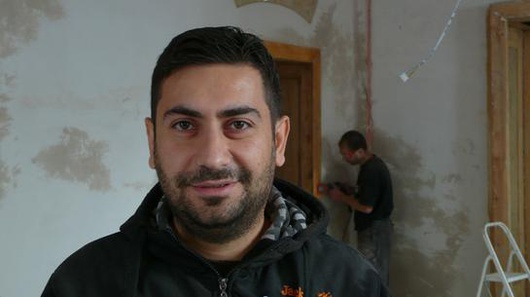 Ferhat is carry out building works
another street corner over. ‘This neighbourhood will be the most
popular in all of Berlin within the next three
years,’ he says, explaining his vision. The 32-year-old
wants to open a kiosk with a deli department at no. 54
Weichselstraße. He is paying 3, 000
euros for almost 300 squared metres.
He proudly shows me every room of the contorted shell construction. He
has torn out old carpets, exposed bricks, polished floorboards, and
invested around 70, 000 euros. He has
high hopes. A neighbour once told him that Weichselstraße was once as
famous and popular as Kurfürstendamm –
Berlin’s answer to Paris‘ Champs-Élysées – is today, with many shops
and pubs. He is now renovating one of these pubs.
Ferhat is carry out building works
another street corner over. ‘This neighbourhood will be the most
popular in all of Berlin within the next three
years,’ he says, explaining his vision. The 32-year-old
wants to open a kiosk with a deli department at no. 54
Weichselstraße. He is paying 3, 000
euros for almost 300 squared metres.
He proudly shows me every room of the contorted shell construction. He
has torn out old carpets, exposed bricks, polished floorboards, and
invested around 70, 000 euros. He has
high hopes. A neighbour once told him that Weichselstraße was once as
famous and popular as Kurfürstendamm –
Berlin’s answer to Paris‘ Champs-Élysées – is today, with many shops
and pubs. He is now renovating one of these pubs.
Ferhat: his kiosk is being renovated | © Franziska Hessberger
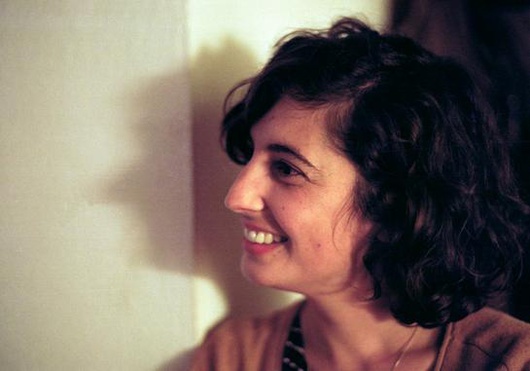 A group of young graphic designers and illustrators are also relying
on the future of Weichselstraße. They have just set up Salon Renate in
building no. 65. Eva,
a graphic designer from Portugal, did one work
placement after the other in Berlin until she decided to become
self-employed; flyers for the next bar or tenant protest campaign could
be designed in her office. She feels inspired by Neukölln’s
day-by-day transformation.
A group of young graphic designers and illustrators are also relying
on the future of Weichselstraße. They have just set up Salon Renate in
building no. 65. Eva,
a graphic designer from Portugal, did one work
placement after the other in Berlin until she decided to become
self-employed; flyers for the next bar or tenant protest campaign could
be designed in her office. She feels inspired by Neukölln’s
day-by-day transformation.
Eva at her office | © Luka Knezevic-Strika
In spite of all of the problems, these are some of the people in Weichselstraße who value the mixture of highly diverse life concepts. But how much change can one place take until it loses what makes it unique?
In partnership with the Paris-based Franco-German office for journalists (Ofaj), this article is a part of Orient Express Tripled, cafebabel.com’s ‘return journey’ series of articles with journalists resident in the Balkans, Turkey, France and Germany

Images: main (cc) kbirkenbach/ flickr; in-text Helge & Ferhat © Franziska Hessberger; all other images by © Luka Knezevic-Strika for Orient Express Reporter Tripled, Berlin 2012, by cafebabel.com



